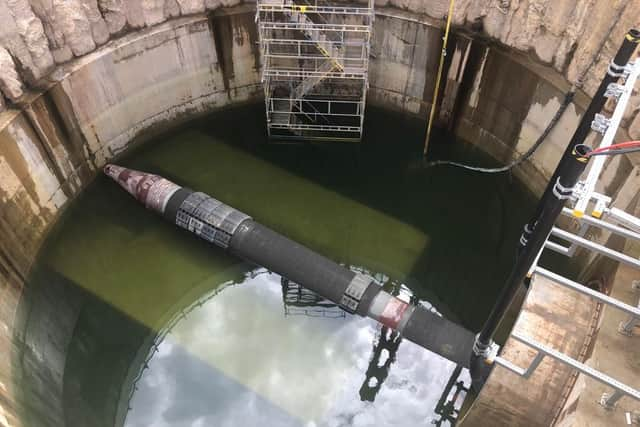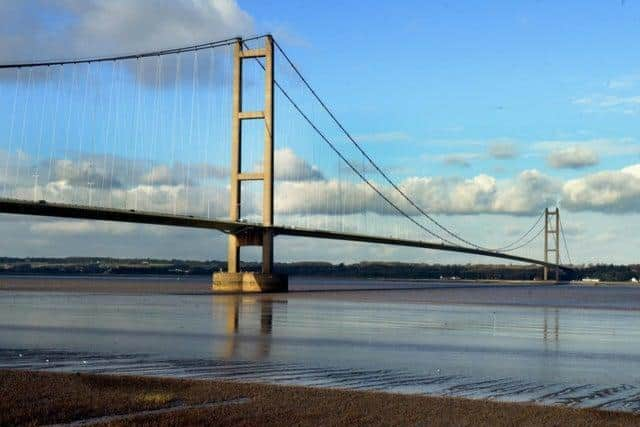Work to build 5 kilometre gas pipeline underneath the Humber completes, creating world's largest hydraulically inserted gas pipeline
The National Grid has been working on the construction of a 5km replacement tunnel, 30m under the River Humber, which when operational will be able to supply a quarter of the entire nation’s gas.
The boring of the tunnel itself took more than 18 months and was completed last year.
Advertisement
Hide AdAdvertisement
Hide AdNow, in the penultimate stage of the project, the last piece of gas pipeline has been inserted.


The pipe consists of eight separate pipe strings, each measuring 620 metres in length, which are inserted with a mechanical thruster which itself weighs 750 tonnes.
As part of the process the individual strings are then welded together, tested and coated.
They are also treated with 50,000 cubic metres of water which is purer than conventional drinking water.
Advertisement
Hide AdAdvertisement
Hide AdThe flooding of this pure and treated water was enough to fill 16 Olympic swimming pools and helped aid the installation process, project bosses said.


The work has been carried out by project partners Skanska, A.Hak and Porr to replace a trench-laid gas pipe which had become exposed.
Long-term project
The problems were first identified 11 years ago following underwater survey inspections.
A temporary remedial solution was put into place in 2010 and required further work in 2012.
Advertisement
Hide AdAdvertisement
Hide AdHowever, although stable, it was subject to risks of both further erosion and third party impact, both of which could result in catastrophic failure of the pipeline.
The new 3.65m diameter tunnel will see gas begin to flow through it towards the end of this year in a move National Grid bosses said would help ensure reliable and resilient supply.
Steve Ellison, Senior Project Manager, Capital Delivery, for National Grid, said: “Completing the installation of the pipeline under the Humber is a major milestone for both the project team and partners.
“We will now begin work to connect the pipeline to the network, ready for gas to begin flowing towards the end of the year.”
Advertisement
Hide AdAdvertisement
Hide AdHe added: “Workers from around the world have worked on the project but we have also had a large contingent of local workers who have developed and gained skills which they can not take away to work on future projects around the country.”
Power
The hydraulic thrust machines began the epic task of carefully pushing eight 850 tonne sections of pipe on rollers into the new tunnel from Goxhill side of the Humber on June 23.
The pipes were methodically pushed at around one metre per minute into the tunnel.
After one pipe section had been installed, the next was moved into position and welded to the one in front.
Advertisement
Hide AdAdvertisement
Hide AdThe push continued until all five kilometres of pipeline were fully installed, becoming the world’s longest hydraulically inserted pipe.
Gregor Craig, CEO of Skanska said: “This fantastic achievement shows what can be achieved when you put three expert companies together and create a highly collaborative environment.
“I am very proud of this joint venture between Ahak, Porr and Skanska. Our customer, National Grid, set us a considerable challenge; in fact a “world’s first” challenge and our team has risen to it brilliantly.
“Whilst we still have a way to go, it is clear that we are on track to provide National Grid with the critical national infrastructure solution that they were seeking."
Advertisement
Hide AdAdvertisement
Hide AdThe River Humber pipeline is part of the national transmission system and connects the import terminal at Easington, on the coast, to the wider network.
Scale of the Humber
The pipeline cross the Humber Estuary, the fourth largest estuary in Britain and the third largest shipping complex.
The estuary experiences maximum tidal flows second only to the River Severn and, as a result, velocities in the Humber can be extremely high and spring tide extremes can reach up to three metres a second. This velocity combined with the high concentration of suspended sediment in the river mean that the estuary bed is highly mobile and constantly changing.
The river’s major tributaries include the Trent, Ouse, Aire, Derwent, Don, and Wharf.
These tributaries combine to drain a catchment area which is amounts to 20 per cent of England’s total area.